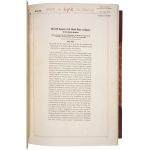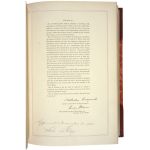Boulder Canyon Project Act
12/21/1928
Add to Favorites:
Add all page(s) of this document to activity:

Add only page 1 to activity:
Add only page 2 to activity:
This act authorized the construction of the Hoover Dam on the Colorado River and the All-American Canal to the Imperial Valley in California.
Long before there was a Boulder Canyon Act or a Hoover Dam, the Colorado River flowed uninterrupted along its 1,450-mile course from the Rocky Mountains to the Gulf of California. Winding through California's richly fertile Imperial Valley, the Colorado River was unpredictable – flooding in the spring, drying up in the summer. The destruction caused when the river flooded in the spring had devastated the farmlands near its banks. By the 1920s, the damage attracted so much attention that it had become necessary and politically expedient to try to control the path of the lower Colorado. Building a dam would provide badly needed electricity to the western states.
The Boulder Canyon Project Act of 1928 authorized construction of a dam in Boulder, or Black, Canyon, construction of the All-American Canal to connect the Imperial and Coachella Valleys with the Colorado River, and divided the lower basin waters among the lower basin states. In addition, the act appropriated $165,000,000 for construction and stated the primary purposes of the project as flood control, improvement of navigation on the Colorado River, storage and delivery of water for reclamation and other beneficial uses, and generation of power. The Boulder Canyon Project Act became effective on June 25, 1929, following ratification of the Colorado River Compact by six of the seven states of the Colorado River Basin.
Before work could start on the project, the Colorado River had to be diverted. To accomplish this, four tunnels, each 50 feet in diameter (which today could accommodate a 747 without the wings), were drilled through the solid rock walls of Black Canyon. When the dam was finished, it stood over 700 feet high, was 1,244 feet across at the top, 660 feet thick at the base, 45 feet thick at the top, and weighed 6.6 million tons; had a power generating capacity of 2.8 million kilowatts; and could store up to 2 years' average flow from the Colorado River in Lake Mead.
About 16,000 men and women worked on the project with approximately 3,500 people employed at any one time. It was dangerous work, and the official death toll was 96. Five thousand men and their families settled in the Nevada desert, most in Boulder City, an efficiently run, well-ordered company town built by the Federal Government. Others lived in dozens of tent cities and honky-tonk towns that sprang up on the road from the dam to the small town of Las Vegas. To a country struggling to come out of the Depression, the project was dramatic evidence of what American brains and manpower could accomplish, and it was a symbol of hope for the dispossessed. In 1935 the job was finished.
No other politician was more responsible for the successful completion of Boulder Dam than Herbert Hoover. Because of his long involvement in the project, from his days as Secretary of Commerce to his tenure as 31st President, the 80th Congress, in 1947, passed legislation officially designating the dam "Hoover Dam." Hoover had called it "the greatest engineering work of its character ever attempted by the hand of man."
Long before there was a Boulder Canyon Act or a Hoover Dam, the Colorado River flowed uninterrupted along its 1,450-mile course from the Rocky Mountains to the Gulf of California. Winding through California's richly fertile Imperial Valley, the Colorado River was unpredictable – flooding in the spring, drying up in the summer. The destruction caused when the river flooded in the spring had devastated the farmlands near its banks. By the 1920s, the damage attracted so much attention that it had become necessary and politically expedient to try to control the path of the lower Colorado. Building a dam would provide badly needed electricity to the western states.
The Boulder Canyon Project Act of 1928 authorized construction of a dam in Boulder, or Black, Canyon, construction of the All-American Canal to connect the Imperial and Coachella Valleys with the Colorado River, and divided the lower basin waters among the lower basin states. In addition, the act appropriated $165,000,000 for construction and stated the primary purposes of the project as flood control, improvement of navigation on the Colorado River, storage and delivery of water for reclamation and other beneficial uses, and generation of power. The Boulder Canyon Project Act became effective on June 25, 1929, following ratification of the Colorado River Compact by six of the seven states of the Colorado River Basin.
Before work could start on the project, the Colorado River had to be diverted. To accomplish this, four tunnels, each 50 feet in diameter (which today could accommodate a 747 without the wings), were drilled through the solid rock walls of Black Canyon. When the dam was finished, it stood over 700 feet high, was 1,244 feet across at the top, 660 feet thick at the base, 45 feet thick at the top, and weighed 6.6 million tons; had a power generating capacity of 2.8 million kilowatts; and could store up to 2 years' average flow from the Colorado River in Lake Mead.
About 16,000 men and women worked on the project with approximately 3,500 people employed at any one time. It was dangerous work, and the official death toll was 96. Five thousand men and their families settled in the Nevada desert, most in Boulder City, an efficiently run, well-ordered company town built by the Federal Government. Others lived in dozens of tent cities and honky-tonk towns that sprang up on the road from the dam to the small town of Las Vegas. To a country struggling to come out of the Depression, the project was dramatic evidence of what American brains and manpower could accomplish, and it was a symbol of hope for the dispossessed. In 1935 the job was finished.
No other politician was more responsible for the successful completion of Boulder Dam than Herbert Hoover. Because of his long involvement in the project, from his days as Secretary of Commerce to his tenure as 31st President, the 80th Congress, in 1947, passed legislation officially designating the dam "Hoover Dam." Hoover had called it "the greatest engineering work of its character ever attempted by the hand of man."
Transcript
AN ACT To provide for the construction of works for the protection and development of the Colorado River Basin, for the approval of the Colorado River compact, and for other purposes.Be it enacted by the Senate and House of Representatives of the United States of America in Congress assembled, That for the purpose of controlling the floods, improving navigation and regulating the flow of the Colorado River, providing for storage and for the delivery of the stored waters thereof for reclamation of public lands and other beneficial uses exclusively within the United States, and for the generation of electrical energy as a means of making the project herein authorized a self-supporting and financially solvent undertaking, the Secretary of the Interior, subject to the terms of the Colorado River compact hereinafter mentioned, is hereby authorized to construct, operate, and maintain a dam and incidental works in the main stream of the Colorado River at Black Canyon or Boulder Canyon adequate to create a storage reservoir of a capacity of not less than twenty million acre-feet of water and a main canal and appurtenant structures located entirely within the United States connecting the Laguna Dam, or other suitable diversion dam, which the Secretary of the Interior is hereby authorized to construct if deemed necessary or advisable by him upon engineering or economic considerations, with the Imperial and Coachella Valleys in California, the expenditures for said main canal and appurtenant structures to be reimbursable, as provided in the reclamation law, and shall not be paid out of revenues derived from the sale or disposal of water power or electric energy at the dam authorized to be constructed at said Black Canyon or Boulder Canyon, or for water for potable purposes outside of the Imperial and Coachella Valleys: Provided, however, That no charge shall be made for water or for the use, storage, or delivery of water for irrigation or water for potable purposes in the Imperial or Coachella Valleys; also to construct and equip, operate, and maintain at or near said dam, or cause to be constructed, a complete plant and incidental structures suitable for the fullest economic development of electrical energy from the water discharged from said reservoir; and to acquire by proceedings in eminent ...
[pages omitted]
... SEC. 18. Nothing herein shall be construed as interfering with such rights as the States now have either to the waters within their borders or to adopt such policies and enact such laws as they may deem necessary with respect to the appropriation, control, and use of waters within their borders, except as modified by the Colorado River compact or other interstate agreement. SEC. 19. That the consent of Congress is hereby given to the States of Arizona, California, Colorado, Nevada, New Mexico, Utah, and Wyoming to negotiate and enter into compacts or agreements, supplemental to and in conformity with the Colorado River compact and consistent with this Act for a comprehensive plan for the development of the Colorado River and providing for the storage, diversion, and use of the waters of said river. Any such compact or agreement may provide for the construction of dams, headworks, and other diversion works or structures for flood control, reclamation, improvement of navigation, division of water, or other purposes and/or the construction of power houses or other structures for the purpose of the development of water power and the financing of the same; and for such purposes may authorize the creation of interstate commissions and/or the creation of corporations, authorities, or other instrumentalities.
(a) Such consent is given upon condition that a representative of the United States, to be appointed by the President, shall participate in the negotiations and shall make report to Congress of the proceedings and of any compact or agreement entered into.
(b) No such compact or agreement shall be binding or obligatory upon any of such States unless and until it has been approved by the legislature of each of such States and by the Congress of the United States.
SEC. 20. Nothing in this Act shall be construed as a denial or recognition of any rights, if any, in Mexico to the use of the waters of the Colorado River system.
SEC. 21. That the short title of this Act shall be “Boulder Canyon Project Act.”
[endorsements]
Approved, December 21, 1928.
This primary source comes from the General Records of the United States Government.
National Archives Identifier: 5730900
Full Citation: An Act of December 21, 1928, Public Law 70-642, 45 STAT 1057, to Provide for the Construction of Works for the Protection and Development of the Colorado River Basin, for the Approval of the Colorado ; 12/21/1928; Series: Enrolled Acts and Resolutions of Congress, 1789 - 2011; General Records of the United States Government, Record Group 11; National Archives Building, Washington, DC. [Online Version, https://www.docsteach.org/documents/document/boulder-canyon-project-act, April 20, 2024]Rights: Public Domain, Free of Known Copyright Restrictions. Learn more on our privacy and legal page.





